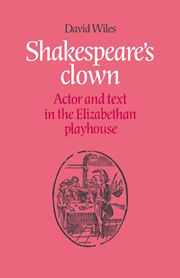Book contents
- Frontmatter
- Contents
- List of illustrations
- Preface
- Acknowledgements
- Note
- 1 The Vice: from Mankind to Merchant of Venice
- 2 Tarlton: the first ‘clown’
- 3 Kemp: a biography
- 4 Kemp's jigs
- 5 ‘The clown’ in playhouse terminology
- 6 The roles of Kemp ‘the clown’
- 7 The genesis of the text: two explorations
- 8 The conventions governing Kemp's scripted roles
- 9 Falstaff
- 10 Robert Armin
- 11 William Kemp and Harry Hunks: play as game, actor as sign — a theoretical conclusion
- Appendix: Armin's motley
- Notes
- Select bibliography
- Index
7 - The genesis of the text: two explorations
Published online by Cambridge University Press: 29 October 2009
- Frontmatter
- Contents
- List of illustrations
- Preface
- Acknowledgements
- Note
- 1 The Vice: from Mankind to Merchant of Venice
- 2 Tarlton: the first ‘clown’
- 3 Kemp: a biography
- 4 Kemp's jigs
- 5 ‘The clown’ in playhouse terminology
- 6 The roles of Kemp ‘the clown’
- 7 The genesis of the text: two explorations
- 8 The conventions governing Kemp's scripted roles
- 9 Falstaff
- 10 Robert Armin
- 11 William Kemp and Harry Hunks: play as game, actor as sign — a theoretical conclusion
- Appendix: Armin's motley
- Notes
- Select bibliography
- Index
Summary
People are often moved to wonder to what extent Shakespeare's actors did justice to the possibilities of the text. The question is rarely framed in reverse: to what extent did the author's text do justice to the possibilities of the actors? The close working relationship between author and actor is usually ignored. I shall examine in this chapter two plays which illuminate this relationship. The existence of alternative published texts can give us insight into the methods of the writer – and, indeed, into the methods of the modern editor.
Romeo and Juliet
In reconstructing the Elizabethan play, we have to take account of three different texts. The ‘bad’ Quarto of 1597 (QI) is a reported text. Scholarship has not established definitively who was responsible for getting this version into print. If one or two actors were recreating the text from memory, as is usually assumed, we should expect certain parts of the play to be better remembered than others. The fact is, however, that the text deteriorates progressively. This points to the possibility that the text was written down, during a series of visits to the theatre, by a spectator whose stamina steadily waned. It is generally hard to tell whether errors in the text are attributable to failings in the reporter(s), or to accurately reported failings in the actors. It is perfectly clear, however, that Q1 records a version actually performed, and that the performance was given by a reduced cast with cuts in the text. The second Quarto (Q2), published in 1599, is mainly derived from Shakespeare's rough manuscript, but the compositor has turned to Q1 for some guidance, mainly in matters of layout.
Information
- Type
- Chapter
- Information
- Shakespeare's ClownActor and Text in the Elizabethan Playhouse, pp. 83 - 98Publisher: Cambridge University PressPrint publication year: 1987
